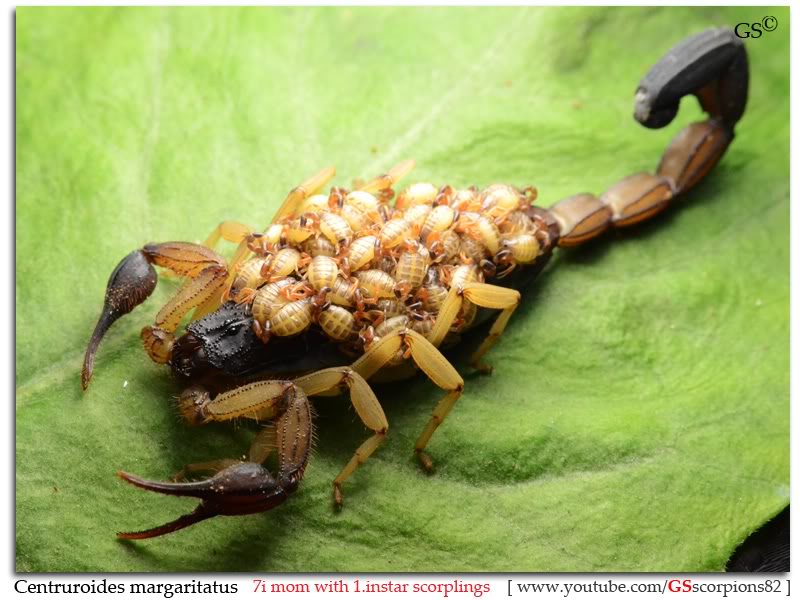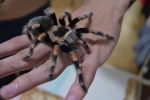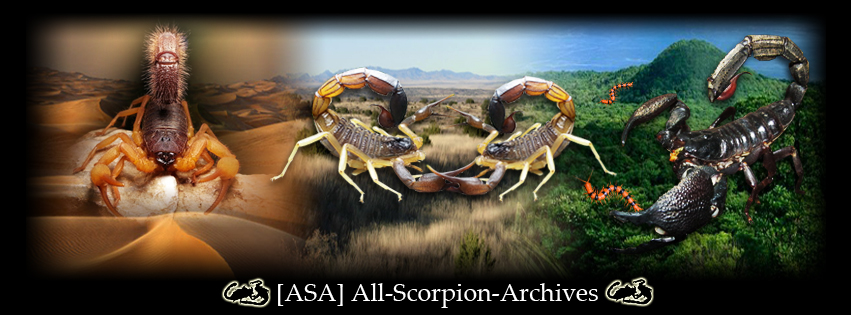[ASA] Centruroides margaritatus caresheet
3 posters
Page 1 of 1
![[ASA] Centruroides margaritatus caresheet Empty](https://2img.net/i/empty.gif) [ASA] Centruroides margaritatus caresheet
[ASA] Centruroides margaritatus caresheet
Dear Hobbyist,
This article is going through a content update. Stay tuned to ASA's News and on www.facebook.com/ScorpionArchives for the official launch
Regards,
GS
[ASA] Centruroides margaritatus caresheet

Centruroides margaritatus (Gervais, 1841)
Origin and occurrence:
Central America (also introduced to Florida)
Size of adults:
Males: 8.5cm +/-
Females (7.instar): 7 +/-
Females (8.instar): 8.5cm +/-
Speed:
Medium
Observation:
Centruroides margaritatus are very adaptable and fast growing specimens. Being not picky eater that readily feeds on anything they can subdue they matures at an amazing speed. Nevertheless, they never fails to impress you with hunting skills while hanging on a bark.
Sexual dimorphism:
Significantly shown at 7.instar, male's metasomal segments are more slender and lengthy as compared to females' with the latter having a more massive body size
![[ASA] Centruroides margaritatus caresheet Centruroides_margaritatus_8i_mating_by_GS_pic9](https://2img.net/h/i1113.photobucket.com/albums/k516/GSscorpions82/Centruroides_Margaritatus/Centruroides_margaritatus_8i_mating_by_GS_pic9.jpg)
![[ASA] Centruroides margaritatus caresheet Centruroides_margaritatus_8i_mating_by_GS_pic2](https://2img.net/h/i1113.photobucket.com/albums/k516/GSscorpions82/Centruroides_Margaritatus/Centruroides_margaritatus_8i_mating_by_GS_pic2.jpg)
Maturity:
Males usually mature at 7.instar.
Females attain sexual maturity (able to produce offsprings) at 7.instar but with ideal conditions and care provided, they are able to attain 8.instar.
![[ASA] Centruroides margaritatus caresheet Centruroides_margaritatus_150711_by_GS_pic1](https://2img.net/h/i1113.photobucket.com/albums/k516/GSscorpions82/Centruroides_Margaritatus/Centruroides_margaritatus_150711_by_GS_pic1.jpg)
7.instar female engaged in mating
![[ASA] Centruroides margaritatus caresheet CentruroidesMargaritatusMatingPic1](https://2img.net/h/i1113.photobucket.com/albums/k516/GSscorpions82/Centruroides_Margaritatus/CentruroidesMargaritatusMatingPic1.jpg)
![[ASA] Centruroides margaritatus caresheet CentruroidesMargaritatusMatingPic2](https://2img.net/h/i1113.photobucket.com/albums/k516/GSscorpions82/Centruroides_Margaritatus/CentruroidesMargaritatusMatingPic2.jpg)
8.instar female engaged in mating
![[ASA] Centruroides margaritatus caresheet Centruroides_margaritatus_8i_mating_by_GS_pic1](https://2img.net/h/i1113.photobucket.com/albums/k516/GSscorpions82/Centruroides_Margaritatus/Centruroides_margaritatus_8i_mating_by_GS_pic1.jpg)
Video mating documentation:
8.instar female
7.instar female
Gestation Period:
3 months +/-
1.instar:
![[ASA] Centruroides margaritatus caresheet Centruroides_margaritatus_i7_with_i1_babies_by_GSscorpions82_pic_15](https://2img.net/h/i1113.photobucket.com/albums/k516/GSscorpions82/Centruroides_Margaritatus/Centruroides_margaritatus_i7_with_i1_babies_by_GSscorpions82_pic_15.jpg)
![[ASA] Centruroides margaritatus caresheet Centruroides_margaritatus_b2_by_GSscorpions82_pic2](https://2img.net/h/i1113.photobucket.com/albums/k516/GSscorpions82/Centruroides_Margaritatus/Centruroides_margaritatus_b2_by_GSscorpions82_pic2.jpg)
![[ASA] Centruroides margaritatus caresheet Centruroides_margaritatus_i7_with_i1_babies_by_GSscorpions82_pic_22a](https://2img.net/h/i1113.photobucket.com/albums/k516/GSscorpions82/Centruroides_Margaritatus/Centruroides_margaritatus_i7_with_i1_babies_by_GSscorpions82_pic_22a.jpg)
2.instar:
![[ASA] Centruroides margaritatus caresheet Centruroides_margaritatus_2instar_by_GSscorpions82_pic1](https://2img.net/h/i1113.photobucket.com/albums/k516/GSscorpions82/Centruroides_Margaritatus/Centruroides_margaritatus_2instar_by_GSscorpions82_pic1.jpg)
![[ASA] Centruroides margaritatus caresheet Centruroides_margaritatus_2instar_by_GSscorpions82_pic7](https://2img.net/h/i1113.photobucket.com/albums/k516/GSscorpions82/Centruroides_Margaritatus/Centruroides_margaritatus_2instar_by_GSscorpions82_pic7.jpg)
Feeding documentation:
Lifecycle observation:
1.instar >> 2.instar: 5 days
2.instar >> 3.instar: 14 days
3.instar >> 4.instar: 19 days
4.instar >> 5.instar: 23 days
5.instar >> 6.instar: 25 days
6.instar >> 7.instar: 27 days
7.instar >> 8.instar: 72 days (female)
Duration to achieve Full maturity:
Male: 108 days / 3.5 months
Female (7.instar): 108 days / 3.5 months
Female (8.instar): 180 days / 6 months
Husbandry (keeping conditions):
Raising Bark Scorpions [ Basic Caresheet ]
This article is going through a content update. Stay tuned to ASA's News and on www.facebook.com/ScorpionArchives for the official launch
Regards,
GS
[ASA] Centruroides margaritatus caresheet

Centruroides margaritatus (Gervais, 1841)
Origin and occurrence:
Central America (also introduced to Florida)
Size of adults:
Males: 8.5cm +/-
Females (7.instar): 7 +/-
Females (8.instar): 8.5cm +/-
Speed:
Medium
Observation:
Centruroides margaritatus are very adaptable and fast growing specimens. Being not picky eater that readily feeds on anything they can subdue they matures at an amazing speed. Nevertheless, they never fails to impress you with hunting skills while hanging on a bark.
Sexual dimorphism:
Significantly shown at 7.instar, male's metasomal segments are more slender and lengthy as compared to females' with the latter having a more massive body size
![[ASA] Centruroides margaritatus caresheet Centruroides_margaritatus_8i_mating_by_GS_pic9](https://2img.net/h/i1113.photobucket.com/albums/k516/GSscorpions82/Centruroides_Margaritatus/Centruroides_margaritatus_8i_mating_by_GS_pic9.jpg)
![[ASA] Centruroides margaritatus caresheet Centruroides_margaritatus_8i_mating_by_GS_pic2](https://2img.net/h/i1113.photobucket.com/albums/k516/GSscorpions82/Centruroides_Margaritatus/Centruroides_margaritatus_8i_mating_by_GS_pic2.jpg)
Maturity:
Males usually mature at 7.instar.
Females attain sexual maturity (able to produce offsprings) at 7.instar but with ideal conditions and care provided, they are able to attain 8.instar.
![[ASA] Centruroides margaritatus caresheet Centruroides_margaritatus_150711_by_GS_pic1](https://2img.net/h/i1113.photobucket.com/albums/k516/GSscorpions82/Centruroides_Margaritatus/Centruroides_margaritatus_150711_by_GS_pic1.jpg)
7.instar female engaged in mating
![[ASA] Centruroides margaritatus caresheet CentruroidesMargaritatusMatingPic1](https://2img.net/h/i1113.photobucket.com/albums/k516/GSscorpions82/Centruroides_Margaritatus/CentruroidesMargaritatusMatingPic1.jpg)
![[ASA] Centruroides margaritatus caresheet CentruroidesMargaritatusMatingPic2](https://2img.net/h/i1113.photobucket.com/albums/k516/GSscorpions82/Centruroides_Margaritatus/CentruroidesMargaritatusMatingPic2.jpg)
8.instar female engaged in mating
![[ASA] Centruroides margaritatus caresheet Centruroides_margaritatus_8i_mating_by_GS_pic1](https://2img.net/h/i1113.photobucket.com/albums/k516/GSscorpions82/Centruroides_Margaritatus/Centruroides_margaritatus_8i_mating_by_GS_pic1.jpg)
Video mating documentation:
8.instar female
7.instar female
Gestation Period:
3 months +/-
1.instar:
![[ASA] Centruroides margaritatus caresheet Centruroides_margaritatus_i7_with_i1_babies_by_GSscorpions82_pic_15](https://2img.net/h/i1113.photobucket.com/albums/k516/GSscorpions82/Centruroides_Margaritatus/Centruroides_margaritatus_i7_with_i1_babies_by_GSscorpions82_pic_15.jpg)
![[ASA] Centruroides margaritatus caresheet Centruroides_margaritatus_b2_by_GSscorpions82_pic2](https://2img.net/h/i1113.photobucket.com/albums/k516/GSscorpions82/Centruroides_Margaritatus/Centruroides_margaritatus_b2_by_GSscorpions82_pic2.jpg)
![[ASA] Centruroides margaritatus caresheet Centruroides_margaritatus_i7_with_i1_babies_by_GSscorpions82_pic_22a](https://2img.net/h/i1113.photobucket.com/albums/k516/GSscorpions82/Centruroides_Margaritatus/Centruroides_margaritatus_i7_with_i1_babies_by_GSscorpions82_pic_22a.jpg)
2.instar:
![[ASA] Centruroides margaritatus caresheet Centruroides_margaritatus_2instar_by_GSscorpions82_pic1](https://2img.net/h/i1113.photobucket.com/albums/k516/GSscorpions82/Centruroides_Margaritatus/Centruroides_margaritatus_2instar_by_GSscorpions82_pic1.jpg)
![[ASA] Centruroides margaritatus caresheet Centruroides_margaritatus_2instar_by_GSscorpions82_pic7](https://2img.net/h/i1113.photobucket.com/albums/k516/GSscorpions82/Centruroides_Margaritatus/Centruroides_margaritatus_2instar_by_GSscorpions82_pic7.jpg)
Feeding documentation:
- Click here to view:
Lifecycle observation:
1.instar >> 2.instar: 5 days
2.instar >> 3.instar: 14 days
3.instar >> 4.instar: 19 days
4.instar >> 5.instar: 23 days
5.instar >> 6.instar: 25 days
6.instar >> 7.instar: 27 days
7.instar >> 8.instar: 72 days (female)
Duration to achieve Full maturity:
Male: 108 days / 3.5 months
Female (7.instar): 108 days / 3.5 months
Female (8.instar): 180 days / 6 months
Husbandry (keeping conditions):
Raising Bark Scorpions [ Basic Caresheet ]
![[ASA] Centruroides margaritatus caresheet Empty](https://2img.net/i/empty.gif) Re: [ASA] Centruroides margaritatus caresheet
Re: [ASA] Centruroides margaritatus caresheet
Hi, are they communal species?

ahxean- Spermatophore
- Posts : 75
Join date : 2013-02-20
Age : 34
Location : Malaysia
![[ASA] Centruroides margaritatus caresheet Empty](https://2img.net/i/empty.gif) Re: [ASA] Centruroides margaritatus caresheet
Re: [ASA] Centruroides margaritatus caresheet
Communal as adults.
Juveniles to sub-adults are still prone to cannibalism when food are scarce. We can reduce the risk by providing more hides and by feeding them well but we can't prevent it 100%.
Smacking any the kids (on the head) for munching on their freshly molted siblings just don't work at all...
It all boils down to how far a risk are you willing to take. If you have only 5 slings, i'll say raise them up separately. If you have a whole brood to raise, why not try a few breeding groups of different numbers, for learning and documenting purpose
Juveniles to sub-adults are still prone to cannibalism when food are scarce. We can reduce the risk by providing more hides and by feeding them well but we can't prevent it 100%.
Smacking any the kids (on the head) for munching on their freshly molted siblings just don't work at all...
It all boils down to how far a risk are you willing to take. If you have only 5 slings, i'll say raise them up separately. If you have a whole brood to raise, why not try a few breeding groups of different numbers, for learning and documenting purpose
![[ASA] Centruroides margaritatus caresheet Empty](https://2img.net/i/empty.gif) Re: [ASA] Centruroides margaritatus caresheet
Re: [ASA] Centruroides margaritatus caresheet
Thank you for the info. 

ahxean- Spermatophore
- Posts : 75
Join date : 2013-02-20
Age : 34
Location : Malaysia
![[ASA] Centruroides margaritatus caresheet Empty](https://2img.net/i/empty.gif) Re: [ASA] Centruroides margaritatus caresheet
Re: [ASA] Centruroides margaritatus caresheet
Can i ask how dangerous it is? Thanks

Smithi Junjun- Spermatophore
- Posts : 1
Join date : 2015-07-07
Age : 27
 Similar topics
Similar topics» WTB: Male Central American Bark Scorpion Centruroides margaritatus.
» [ASA] Centruroides nigrescens caresheet
» Centruroides gracilis
» Centruroides limbatus
» Centruroides nigrescens
» [ASA] Centruroides nigrescens caresheet
» Centruroides gracilis
» Centruroides limbatus
» Centruroides nigrescens
Page 1 of 1
Permissions in this forum:
You cannot reply to topics in this forum